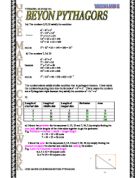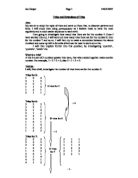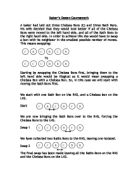Beyond Pythagoras
a) The numbers 5,12,13 satisfy the condition a2 + b2 = c2 52 + 122 = 132 52 = 5 x 5 = 25 122 = 12 x 12 = 144 132 = 13 x 13 = 169 and so 52+ 122 = 25 + 144 = 169 = 132 b) The numbers 7, 24, 25 a2 + b2 = c2 72 + 242 = 25 because 72 = 7 x7 = 49 242 = 24 x 24 = 576 252 = 25 x 25 = 625 and so 72 + 242 = 49 + 576 = 625 = 25 2 The numbers above satisfy similar condition that is pythagors theorem. I have tested the numbers by putting them into the formula a2 + b2 = c2. This is means the numbers are a Pythagorean triple because they satisfy the condition a2 + b 2 = c2 2) Length of shortest side Length of middle side Length of longest side Perimeter Area 3 4 5 2 6 5 2 3 30 30 7 24 25 56 84 9 40 41 90 80 a) I found the perimeter for the sequence 5, 12, 13 and 7, 24, 2, by simply finding the sum (add) all the lengths of the three sides together to get the perimeter. E.g. Perimeter = shortest +middle + longest length 5 + 12 + 13 = 30 units 7 + 24 + 25 = 56 units I found the area for the sequences 5, 12, 13 and 7, 24, 25, by simply finding the product (multiply) the shortest and middle and halving the answer. E.g. Area = 1/2 x shortest x middle length 1/2 x 5 x 12 = 30 square units 1/2 x 7x 24 = 84 square units I used this method for the area because it is a right-angled triangle. The dotted lines above show that it is actually
In this investigation I am trying to find a rule for the difference between any consecutive numbers in a sequence. I am going to use a series of algebraic expressions to try and come up with a successful rule that works for every consecutive number I try.
Math's Investigation Consecutive Numbers Introduction In this investigation I am trying to find a rule for the difference between any consecutive numbers in a sequence. I am going to use a series of algebraic expressions to try and come up with a successful rule that works for every consecutive number I try. 2 Consecutive Numbers ,2 = 3 2,3 = 5 3,4 = 7 4,5 = 9 3 Consecutive Numbers ,2,3 = 6 2,3,4 = 9 3,4,5 = 12 4,5,6 = 15 4 Consecutive Numbers ,2,3,4 = 10 2,3,4,5 = 14 3,4,5,6 = 18 4,5,6,7 = 22 As you can see from these results if I carry on the difference goes up by 4 each time. 5 Consecutive Numbers ,2,3,4,5 = 15 2,3,4,5,6 = 20 3,4,5,6,7 = 25 4,5,6,7,8 = 30 Difference goes up by 5 each time. 6 Consecutive Numbers ,2,3,4,5,6 = 21 2,3,4,5,6,7 = 27 3,4,5,6,7,8 = 33 4,5,6,7,8,9 = 39 Difference goes up by 6 each time. I have chosen to display results from 2-6 consecutive numbers. I have done this because I think it is an adequate amount of data to find and predict patterns in the sequences. There is also no need to go any further than 6 because I have noticed a pattern, the pattern is: how ever many numbers there are in the sequence it equals the difference between each answer in that sequence every time... As you can see above, for 5 Consecutive numbers the difference goes up in 5's every time, 6 consecutive numbers the difference goes up in
Study the topic of trios and work on from that, to discover patterns and links.
Trios and Extensions of Trios Aim: My aim is to study the topic of trios and work on from that, to discover patterns and links. I will study trios using permutations as I believe these to have the most regularity and a much easier sequence to work with. I am going to investigate how many trios there are for the number 5. Once I have worked this out, I will work out how many trios there are for the number 6; then for the number 7 and so on. I will then try to make a connection between the above numbers and come up with a formula which can be used to work out a trio. I will then explore further into this question, by investigating 'quartets', 'quintets', 'sextet' etc. What is a trio? A trio is a set of 3 numbers greater than zero, that when added together make another number. For example, 1 + 2 + 2 = 5, also 2 + 1 + 2 = 5. TRIOS: I will, first of all, investigate the number of trios there are for the number 5: Trios for 5: 2 2 2 1 2 2 2 1 1 3 3 1 3 1 1 Trios for 6: 2 2 2 3 2 1 3 1 2 2 1 3 2 3 1 4 1 1 4 1 1 4 2 3 3 2 Trios for 7: 3 2 2 5 1 1 2 3 2 1 5 1 2 2 3 1 1 5 2 4 1 3 3 4 2 3 1 3 2 4 1 3 3 1 2 1 4 4 2 1 4 1 2 Trios for 8: 2 5 5 2 2 5 1 2 1 5 5 1 2 5 2 1 3 4 4 3 3 4 1 3 1 4 4 3 1 4 1 3 6 1 1 6 1 1 6 2 2 4 2 4 2 4 2 4 2 3 3 3 2 3 3 3 2 Numbers of trios: 5 --> 6 6 --> 10 7 --> 15 8 --> 21 I
To investigate consecutive sums. Try to find a pattern, devise a formulae and establish which numbers cannot be made using consecutive sums.
Introduction The Assigned Task To investigate consecutive sums. Try to find a pattern, devise a formulae and establish which numbers cannot be made using consecutive sums. To Solve the Task I am going to approach the task systematically, by running through the first twenty sums up to 5 consecutive. I shall devise a formulae and attempt to prove it. What I am Going to Do I am going to devise formulae and work out the answer to a sum I have not already done. I shall then go on to prove it by adding the sum manually. After consecutive sums have been fully investigated, I intend to take it further by investigating into consecutive minuses, squares etc. Tables shall be used where appropriate. Essential ideas may be marked in green, formulae etc., in blue. Consecutive Sums The Following Pages The following pages shall be used for the working out of many consecutive sums and their formulae. The formula for this is 2n-1 Where n is the tern. (All ready a pattern of +2 is clearly visible) I am now going to prove this theory. 8+9=17 2n-1 2x9-1=17 I will also use a sum I have not previously worked out. 65+66=131 2n-1 2x66-1=131 0 + = + 2 = 3 2 + 3 = 5 3 + 4 = 7 4 + 5 = 9 5 + 6 = 1 6 + 7 = 3 7 + 8 = 5 8 + 9 = 7 9 + 0 = 9 0 + 1 = 21 1 + 2 = 23 2 + 3 = 25 3 + 4 = 27 4 + 5 = 29 5 + 6 = 31
Matrix Powers
Table of contents: Questions: .) Consider the Matrix M= Calculate Mn for n= 2, 3, 4, 5, 10, 20, 50. Describe in words any pattern you observe. Use this pattern to find a general expression for the matrix Mn in terms of n. 2.) Consider the matrices P= and S= P2= 2 = =; S2= 2 = = Calculate Pn and Sn for other values of n and describe any pattern you observe. 3.) Now consider matrices of the form steps 1 and 2 contain examples of these matrices for K=1 2 and 3. Consider other values of k, and describe any pattern(s) you observe. Generalize these results in terms of K and N 4.) Use technology to investigate what happens with further values of k and n. State the scope or limitations of k and n. 5.) Explain why your results holds true in general. SL type 1: Matrix Powers ) a) To calculate the value for matrix 'M' when n=2, the matrix must be multiplied by an exponent of 2. This would be shown and calculated as, x Therefore the value of matrix M2 = b) To calculate the value for matrix 'M' when n=3, the matrix must be multiplied by an exponent of 3. Therefore the value of M3 = c) To calculate the value for matrix 'M' when n= 4, the matrix x must be multiplied by an exponent of 4. Therefore the value of M4= d) To calculate the value for matrix 'M' when n=5, the matrix must be multiplied by an exponent of 5. Therefore the value of M5= e) To calculate the
Borders and squares
Roxanne Dabiri BORDERS INTRODUCTION In this investigation I have been asked to find out how many squares would be needed to make up a certain pattern according to its sequence. The pattern is made up of squares surrounded by other square shapes to form a bigger cross-shape. * I will start of by drawing the squares (on the next page). The diagram will start with 1 square and each time I will add squares to each corner of the previous square. * I will count the number of squares in each diagram. After that I will put the numbers in a table. * Then I will see how many squares are added each time. Basically I will find the difference. * After finding the difference I will do a general rule to do find the equation. * Then I will test my rule to see if it is right or wrong. In this experiment I am going to need: * A calculator * A pencil * Variety of sources of information * A ruler PREDICTION I predict that we will find a constant difference between the number of cubes and from there we will be able to find the formula. I also predict that in this project we will get the formula (2n2) - 2n+1. Now I am going to draw the diagrams: 2 3 4 5 6 I have achieved the following information by drawing out the pattern and extending upon it. Seq. no 2 3 4 5 6 No. Of cubes 5 3 25 41 61 I am going to use this next method to see
Maths - Baker's Dozen
Baker's Dozen Coursework A baker had laid out three Chelsea Buns (C) and three Bath Buns. His wife decided that they would look better if all of the Chelsea Buns were moved to the left hand side, and all of the Bath Buns to the right hand side. In order to achieve this she would have to swap a bun with its neighbour in the smallest possible number of moves. This means swapping: To Starting by swapping the Chelsea Buns first, bringing them to the left hand side would be illogical as it would mean swapping a Chelsea Bun with a Chelsea Bun. So, in this case we will start with moving the Bath Buns first. We start with one Bath Bun on the RHS, and a Chelsea bun on the LHS. Start We are now bringing the Bath Buns over to the RHS, forcing the Chelsea Buns to the LHS. Swap 1 We have collected two Baths Buns to the RHS, leaving one isolated. Swap 2 The final swap has been made leaving all the Baths Buns on the RHS and the Chelsea Buns on the LHS. Swap 3 After investigating with other possible solutions I have deducted that the smallest number of swaps needed to sort out three Chelsea Buns and three Bath Buns is three, as shown above. In the second question I intend to a formula to calculate the number of swaps for any number of buns. To do this I had to investigate how many swaps are needed with different amount of buns e.g. two of each bun and six of each
Investigate the sequence of squares in a pattern.
Borders Coursework Aim: To investigate the sequence of squares in a pattern as shown below: In this investigation, I have been asked to find out how many squares would be needed to make up a certain pattern according to its sequence. In this investigation I hope to find a formula which could be used to find out the number of squares needed to build the pattern at any sequential position. Firstly I will break the problem down into simple steps to begin with and go into more detail to explain my solutions such as the nth term. I will illustrate fully any methods I should use and explain how I applied them to this certain problem. I will firstly carry out this experiment on a 2D pattern and then extend my investigation to 3D. Apparatus: Variety of sources of information A calculator A pencil A pen Paper Ruler A computer to work out equations on I have come up with the following numbers and sequences. This was done by drawing out the sequence. Seq no 2 3 4 5 6 7 No of squares 5 3 25 41 61 85 I will use these numbers to try to create a type of formula to get any no of squares in any sequence. +3+1 5 2 +3+5+3+1 3 3 +3+5+7+5+3+1 25 4 +3+5+7+9+7+5+3+1 41 5 +3+5+7+9+11+9+7+5+3+1 61 6 +3+5+7+9+11+13+11+9+7+5+3+1 85 Firstly, I have noticed that if you take the patterns, you can notice that the patterns go up by intervals of two. In
Towers of Hanoi
Towers of Hanoi Introduction: Towers of Hanoi is a puzzle/game in which you have to move a certain number of discs from pole a to pole c in the minimum amount of moves possible. There are a few certain rules you have to follow though: . You CANNOT move 2 discs at a time 2. You CANNOT place a smaller disc over a bigger disc. Aim: The main of the investigation is to enquire into the relationship between the number of discs and the minimum number of moves to complete. We also have to investigate the symmetry of where the disc's go and move to the poles. Also number of moves made by the individual discs to be moved at each stage of the process. We also have to find a formula linking the minimum no of moves to the number of discs. How I went about finding this data: When we were told to investigate Towers of Hanoi we had to figure how many moves it would take to get to pole C in the least amount of moves for 4 discs. So I got a plain piece of paper and drew the three poles on it. Then I got 4 different coloured pieces of paper from the teacher and sat down and tried figuring it out. I also played the game on the schools computers. It was more effective playing it on the computer because you can see some animation rather than seeing bits of paper, also it doesn't seem time consuming when on the computers. The game is also on the Internet on a variety of sites but I
Fraction Differences
Fraction Differences First Sequence To begin with I looked at the first sequence of fractions to discover the formula that explained it. As all the numerators were 1 I looked at the denominators. As these all increased by 1 every time, I figured that the formula was simply as the denominators corresponded to the implied first line as shown in this table below: nth number 2 3 4 5 6 7 8 Denominators 2 3 4 5 6 7 8 I shall call this Formula 1 (F1) for easy reference. Second Sequence Again I decided to discount the numerator as it was 1, and I decided to concentrate on the differences between the denominators rather than the 'fractions'. So I am looking for a formula that will explain the sequence: 2, 6, 12, 20, 30. First of all though I decided to extend the sequence in order to have a broader range to work with. I used a calculator to work out the following denominators finding the difference between and , and all the way up to I set the differences out in a table to try to find the pattern: nth number 2 3 4 5 6 7 8 9 Sequence 2 6 2 20 30 42 56 72 90 First Difference 4 6 8 0 2 4 6 8 Second Difference 2 2 2 2 2 2 2 2 As there was a constant difference of 2 I believed that the formula would include n². I applied this to the first number in the sequence '2'. So n² = (1 x 1 = 1). To get the first number of











